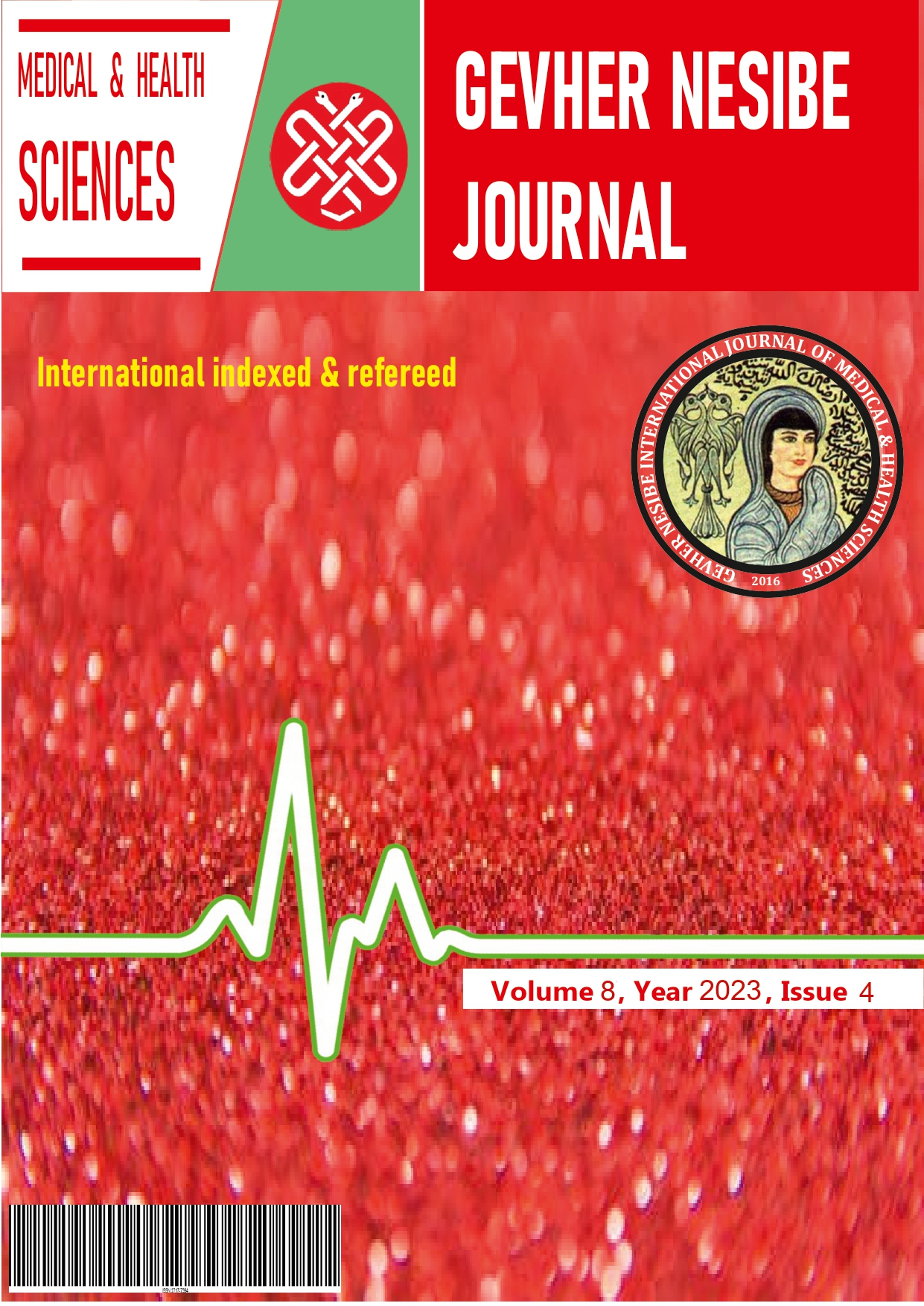Evaluation of Iodine Deficiency Status of Children Diagnosed with Celiac Disease by Spot Urine Iodine/Creatinine Ratio
DOI:
https://doi.org/10.5281/zenodo.10048848Keywords:
children, celiac disease, gluten, iodine, urine iodine/creatinine ratioAbstract
Aim: Celiac disease (CD) is caused by gluten sensitivity which leads to intestinal villi damage. This damage and strict diet can cause vitamin and mineral deficiencies; such as iodine. The aim of this study is to assess the iodine deficiency status in children diagnosed with CD by measuring spot urine iodine/creatinine levels.
Material-Method: Totally 66 (42 girls, 24 boys) children with CD who were followed up in Pediatric Gastroenterology Outpatient Clinic between 18.09.2017-01.12.2022 were included in this retrospective study. Anthropometric and laboratory data were obtained from patient files. All the clinical, biochemical values and spot urine iodine/creatinine ratio were analyzed.
Results: The mean age of the patients was 9.73 ± 3.84 years, and the mean age at diagnosis was 6.57 ± 3.86 years, disease duration was 3.16 ± 2.34 years. The mean spot urinary iodine/creatinine ratio of the participants was 146.20 ± 113.59 μg/g. According to multivariate analysis results, a significant negative correlation was determined between mean patient age and urinary iodine/creatinine ratio (p = 0.009). No significant correlation between other parameters were found (p > 0.05). The patients were divided into two groups: Group 1; as the group with adequate dietary compliance, Group 2; insufficient dietary compliance. The mean spot urinary iodine/creatinine ratio of Group 1 was higher than Group 2, but this difference was not statistically significant (152.26 ± 120.51 μg/g vs. 134.65 ± 100.68 μg/g; p=0.560). The other parameters were also statistically insignificant (p>0.05).
Conclusion: This is the first study in the literature to use the spot urinary iodine/creatinine ratio in the evaluation of iodine deficiency in children and adolescents with CD. The mean spot urinary iodine/creatinine ratio of celiac patients in our study was similar in healthy populations of the same age group, regardless of dietary adherence. In this area; prospective, randomized controlled studies with more subjects are needed.
References
Abadie, V., Kim, S. M., Lejeune, T., Palanski, B. A., Ernest, J. D., Tastet, O., … Jabri, B. (2020). IL-15, gluten and HLA-DQ8 drive tissue destruction in coeliac disease. Nature, 578(7796), 600–604. https://doi.org/10.1038/s41586-020-2003-8
Çelmeli, G., Çürek, Y., Özen Kücükçetin, İ., Arslan Gülten, Z., Özdem, S., Akçurin, S., & Bircan, İ. (2020). The Results of 16 Years of Iodization: Assessment of Iodine Deficiency Among School-age Children in Antalya, Turkey. Journal of Clinical Research in Pediatric Endocrinology, 12(3), 256–260. https://doi.org/10.4274/jcrpe.galenos.2020.2019.0168
Costa Leite, J., Keating, E., Pestana, D., Cruz Fernandes, V., Maia, M., Norberto, S., … Calhau, C. (2017). Iodine Status and Iodised Salt Consumption in Portuguese School-Aged Children: The Iogeneration Study. Nutrients, 9(5), 458. https://doi.org/10.3390/nu9050458
Delvecchio, M., Bizzoco, F., Lapolla, R., Gentile, A., Carrozza, C., Barone, M., … Francavilla, R. (2021). Iodine Absorption in Celiac Children: A Longitudinal Pilot Study. Nutrients, 13(3), 808. https://doi.org/10.3390/nu13030808
Doggui, R., El Ati-Hellal, M., Traissac, P., Lahmar, L., & El Ati, J. (2016). Adequacy Assessment of a Universal Salt Iodization Program Two Decades after Its Implementation: A National Cross-Sectional Study of Iodine Status among School-Age Children in Tunisia. Nutrients, 9(1), 6. https://doi.org/10.3390/nu9010006
Fasano, A., & Catassi, C. (2005). Coeliac disease in children. Best Practice & Research. Clinical Gastroenterology, 19(3), 467–478. https://doi.org/10.1016/j.bpg.2005.01.008
Green, P. H. R., & Cellier, C. (2007). Celiac disease. The New England Journal of Medicine, 357(17), 1731–1743. https://doi.org/10.1056/NEJMra071600
Knudsen, N., Christiansen, E., Brandt-Christensen, M., Nygaard, B., & Perrild, H. (2000). Age- and sex-adjusted iodine/creatinine ratio. A new standard in epidemiological surveys? Evaluation of three different estimates of iodine excretion based on casual urine samples and comparison to 24 h values. European Journal of Clinical Nutrition, 54(4), 361–363. https://doi.org/10.1038/sj.ejcn.1600935
Miranda, J., Lasa, A., Bustamante, M. A., Churruca, I., & Simon, E. (2014). Nutritional differences between a gluten-free diet and a diet containing equivalent products with gluten. Plant Foods for Human Nutrition (Dordrecht, Netherlands), 69(2), 182–187. https://doi.org/10.1007/s11130-014-0410-4
Monachesi, C., Verma, A. K., Catassi, G. N., Galeazzi, T., Franceschini, E., Perticaroli, V., … Catassi, C. (2021). Quantification of Accidental Gluten Contamination in the Diet of Children with Treated Celiac Disease. Nutrients, 13(1), E190. https://doi.org/10.3390/nu13010190
Nerhus, I., Odland, M., Kjellevold, M., Midtbø, L. K., Markhus, M. W., Graff, I. E., … Øyen, J. (2019). Iodine status in Norwegian preschool children and associations with dietary iodine sources: The FINS-KIDS study. European Journal of Nutrition, 58(6), 2219–2227. https://doi.org/10.1007/s00394-018-1768-0
Nicola, J. P., Basquin, C., Portulano, C., Reyna-Neyra, A., Paroder, M., & Carrasco, N. (2009). The Na+/I- symporter mediates active iodide uptake in the intestine. American Journal of Physiology. Cell Physiology, 296(4), C654-662. https://doi.org/10.1152/ajpcell.00509.2008
Vejbjerg, P., Knudsen, N., Perrild, H., Laurberg, P., Andersen, S., Rasmussen, L. B., … Jørgensen, T. (2009). Estimation of iodine intake from various urinary iodine measurements in population studies. Thyroid: Official Journal of the American Thyroid Association, 19(11), 1281–1286. https://doi.org/10.1089/thy.2009.0094
Downloads
Published
How to Cite
Issue
Section
License
Copyright (c) 2023 GEVHER NESIBE JOURNAL OF MEDICAL AND HEALTH SCIENCES

This work is licensed under a Creative Commons Attribution-NonCommercial 4.0 International License.


